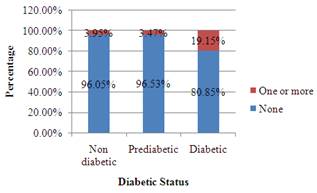
Concept explainers
(a)
To find: the proportion of the women in this study had a child with one or more birth defect.
(a)
Answer to Problem T1.12SPT
0.0439
Explanation of Solution
Given:
| Non diabetic | Pre diabetic | Diabetic | |
| Non | 754 | 362 | 38 |
| one or more | 31 | 13 | 9 |
Calculation:
Suppose first find the row/ column totals, which is the sum of all counts in the associating row/ column.
| Non diabetic | Pre diabetic | Diabetic | total | |
| Non | 754 | 362 | 38 | 1154 |
| one or more | 31 | 13 | 9 | 53 |
| total | 785 | 375 | 47 | 1207 |
It is observed the table is having the data about 1207 women and that 53 of the 1207 women had a child with one or more birth defects (as 53 is mentioned in the row “One or more” and in the column “Row Total” of the above table).
Therefore is a proportion of 0.0439 women had a child with one or more birth defects.
(b)
To find: the percent of the women in this study were diabetic or pre diabetic.
(b)
Answer to Problem T1.12SPT
1.823%
Explanation of Solution
Given:
| Non diabetic | Pre diabetic | Diabetic | |
| Non | 754 | 362 | 38 |
| one or more | 31 | 13 | 9 |
Calculation:
Let us first determine the row/column totals of the given table, which is the sum of all counts in the associating row/ column.
| Non diabetic | Pre diabetic | Diabetic | total | |
| Non | 754 | 362 | 38 | 1154 |
| one or more | 31 | 13 | 9 | 53 |
| total | 785 | 375 | 47 | 1207 |
It is observed that the table is having the data about 1207 women and that 13 of the 1207 women were pre diabetic and had a child with one or more birth defects where 9 of the 1207 women were diabetic and had a child with one or more birth defects
Therefore 1.823% of the women in the study was pre diabetic, and has a child with one or more birth defects.
(c)
To construct: a segmented bar graph to show the distribution of number of birth defects for the women with every three diabetic statues.
(c)
Explanation of Solution
Calculation:
Let us first find the row/column totals of the given table, which is the sum of all counts in the associating row/ column.
| Non diabetic | Pre diabetic | Diabetic | total | |
| Non | 754 | 362 | 38 | 1154 |
| one or more | 31 | 13 | 9 | 53 |
| total | 785 | 375 | 47 | 1207 |
To find the distribution of superpower preference from every country, and divide the counts by the column total.
| Non diabetic | Pre diabetic | Diabetic | |
| None | 96.05% | 96.53% | 80.85% |
| One or more | 3.95% | 3.47% | 19.15% |
Graph:

The width of the every bar has to be the same and the height has to be equal to the percent.
(d)
To Explain: the nature of the association between mother’s diabetic status and number of birth defects for the women in this study.
(d)
Answer to Problem T1.12SPT
The number of birth defects gets to be highest for the Diabetics and lowest for the Non diabetics.
Explanation of Solution
Given:
From the part (c)

It is observed that the number of birth defects gets to be highest for the Diabetics and lowest for the Non diabetics, the reason is that the green area of the bars is greatest for Diabetic and least for non diabetic.
Chapter 1 Solutions
PRACTICE OF STATISTICS F/AP EXAM
Additional Math Textbook Solutions
Introductory Statistics
Elementary Statistics: Picturing the World (7th Edition)
Elementary Statistics: Picturing the World (6th Edition)
Intro Stats, Books a la Carte Edition (5th Edition)
An Introduction to Mathematical Statistics and Its Applications (6th Edition)
Basic Business Statistics, Student Value Edition
 MATLAB: An Introduction with ApplicationsStatisticsISBN:9781119256830Author:Amos GilatPublisher:John Wiley & Sons Inc
MATLAB: An Introduction with ApplicationsStatisticsISBN:9781119256830Author:Amos GilatPublisher:John Wiley & Sons Inc Probability and Statistics for Engineering and th...StatisticsISBN:9781305251809Author:Jay L. DevorePublisher:Cengage Learning
Probability and Statistics for Engineering and th...StatisticsISBN:9781305251809Author:Jay L. DevorePublisher:Cengage Learning Statistics for The Behavioral Sciences (MindTap C...StatisticsISBN:9781305504912Author:Frederick J Gravetter, Larry B. WallnauPublisher:Cengage Learning
Statistics for The Behavioral Sciences (MindTap C...StatisticsISBN:9781305504912Author:Frederick J Gravetter, Larry B. WallnauPublisher:Cengage Learning Elementary Statistics: Picturing the World (7th E...StatisticsISBN:9780134683416Author:Ron Larson, Betsy FarberPublisher:PEARSON
Elementary Statistics: Picturing the World (7th E...StatisticsISBN:9780134683416Author:Ron Larson, Betsy FarberPublisher:PEARSON The Basic Practice of StatisticsStatisticsISBN:9781319042578Author:David S. Moore, William I. Notz, Michael A. FlignerPublisher:W. H. Freeman
The Basic Practice of StatisticsStatisticsISBN:9781319042578Author:David S. Moore, William I. Notz, Michael A. FlignerPublisher:W. H. Freeman Introduction to the Practice of StatisticsStatisticsISBN:9781319013387Author:David S. Moore, George P. McCabe, Bruce A. CraigPublisher:W. H. Freeman
Introduction to the Practice of StatisticsStatisticsISBN:9781319013387Author:David S. Moore, George P. McCabe, Bruce A. CraigPublisher:W. H. Freeman





